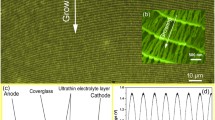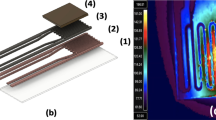Abstract
Carbonaceous deposits produced on Ru-capped multilayer mirrors under extreme ultra violet irradiation in the presence of adventitious gaseous hydrocarbons are a major obstacle to process implementation of EUV lithography. Here, by means of synchrotron radiation and laboratory measurements we show how carbon contamination occurs as a result of photoelectron-induced surface chemistry. We also demonstrate how a device based on an oxygen ion conducting solid electrolyte can act as a sensitive and reproducible sensor for detection of trace amounts of hydrocarbons in high vacuum environments.






Similar content being viewed by others
References
Kyriakou G, Davis DJ, Grant RB, Watson DJ, Keen A, Tikhov MS, Lambert RM (2007) J Phys Chem C 111:4491
Davis DJ, Kyriakou G, Grant RB, Tikhov MS, Lambert RM (2007) J Phys Chem C 111:12165
Kyriakou G, Davis DJ, Grant RB, Tikhov MS, Keen A, Pakianathan P, Lambert RM (2006) J Phys Chem B 110:24571
Davis DJ, Kyriakou G, Grant RB, Tikhov MS, Lambert RM (2007) J Phys Chem C 111:1491
Boller K, Haelbich RP, Hogrefe H, Jark W, Kunz C (1983) Nucl Instrum Method 208:273
Moulder JF, Stickle WF, Sobol PE, Bomben KD, (1995) Handbook of X-ray photoelectron spectroscopy physical electronics. Perkin-Elmer, Minnesota
Tanuma S, Powell CJ, Penn DR (2004) Surf Interface Anal 36:1
Kyriakou G, Davis DJ, Lambert RM (2006) Sens Actuators B Chem 114:1013
Lawrence N (2006) Talanta 69:385
Fleming WJ (1977) J Electrochem Soc 124:21
Radhakrishann R, Virkar AV, Singhal SC, Dunham GC, Marina OA (2005) Sens Acuators B 105:312
Sridhar KR, Blanchard JA, (1999) Sens Actuators B 59:60
Fujiwara Y, Kaimai A, Hong J, Yashiro K, Nigara Y, Kawada T, Mizusaki J (2003) J Electrochem Soc 150:E117
Eguchi Y, Watanabe S, Kubota N, Takeuchi T, Oshihara T, Takita Y (2000) Sens Actuators B 66:9
Luerßen B, Günther S, Marbach H, Kiskinova M, Janek J, Imbihl R (2000) Chem Phys Lett 316:331
Aita CR, Tran Ngoc C (1984) J Appl Phys 56:958
Yoshida H, Nonoyama Y, Yazawa Y, Hattori T (2005) Physica Scripta T115:813
Vayenas CG, Lambert RM, Ladas S, Bebelis S, Neophytides S, Tikhov MS, Filking NC, Makri M, Tsilpakides D, Cavalca C, Besocke K (1997) Studies Surf Sci Catal 112:39
Derry GN, Ross PN, (1986) J Chem Phys 82:2772
Vayenas CG, Bebelis S, Ladas S, (1990) Nature 343:625
Davis DJ, Kyriakou G, Lambert RM (2006) J Phys Chem B 110:11958
Yeh JJ, Lindau I, (1985) Atomic Nucl Data Tables 32:1
Persden MØ, Helveg S, Ruban A, Stensgaard I, Lægsgaad E, Nørskov JK, Besenbacher F (1999) Surf Sci 426:395
Sachtler JWA, Somorjai GA (1983) J Catal 81:77
Acknowledgements
The authors acknowledge funding from BOC Edwards and the UK Engineering and Physical Sciences Research Council (EPSRC).
Author information
Authors and Affiliations
Corresponding author
Rights and permissions
About this article
Cite this article
Kyriakou, G., Stevens, A.V., Davis, D.J. et al. Amperometric/potentiometric hydrocarbon sensors: real world solutions for use in ultra high vacuum. J Appl Electrochem 38, 1089–1096 (2008). https://doi.org/10.1007/s10800-008-9568-5
Received:
Revised:
Accepted:
Published:
Issue Date:
DOI: https://doi.org/10.1007/s10800-008-9568-5




